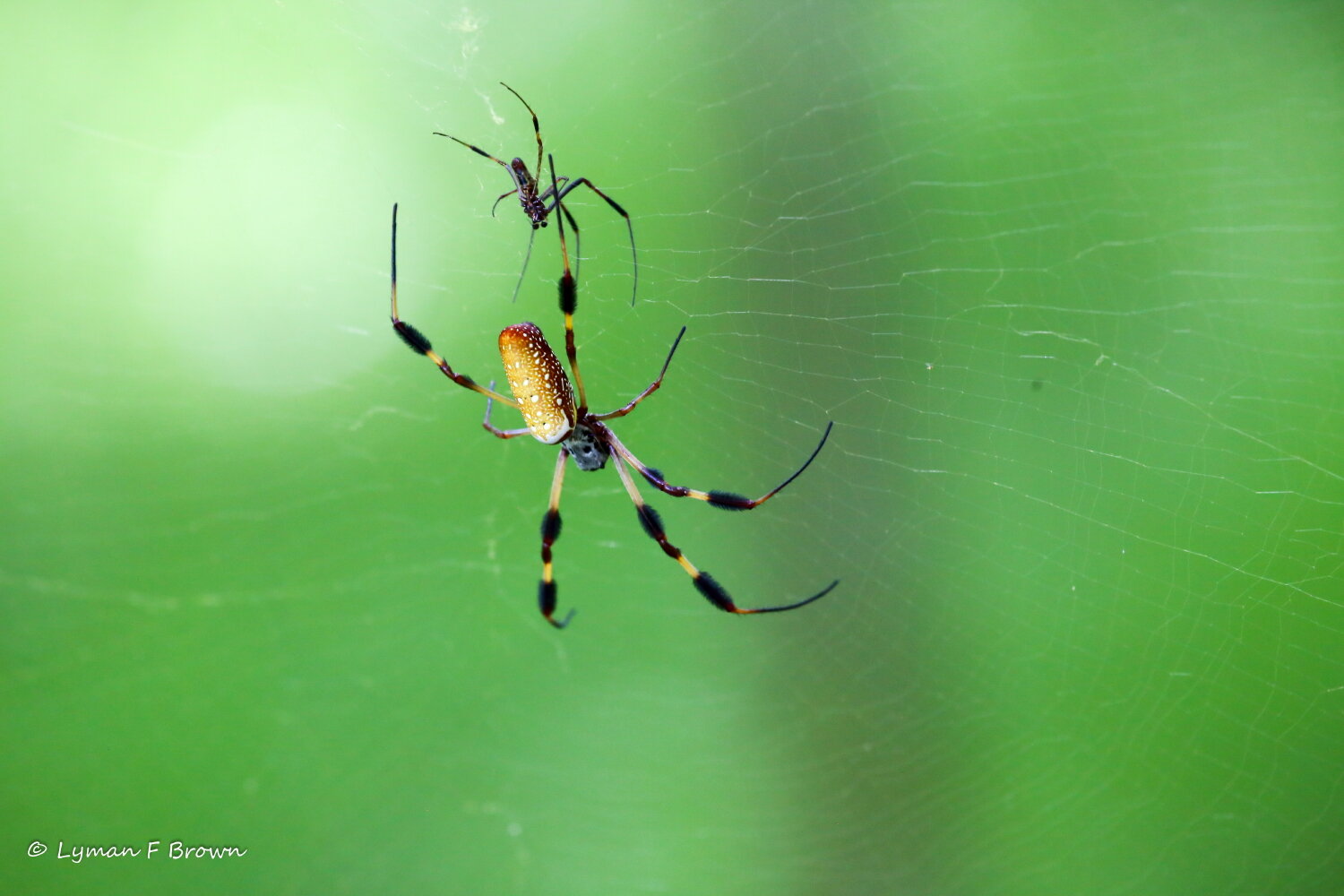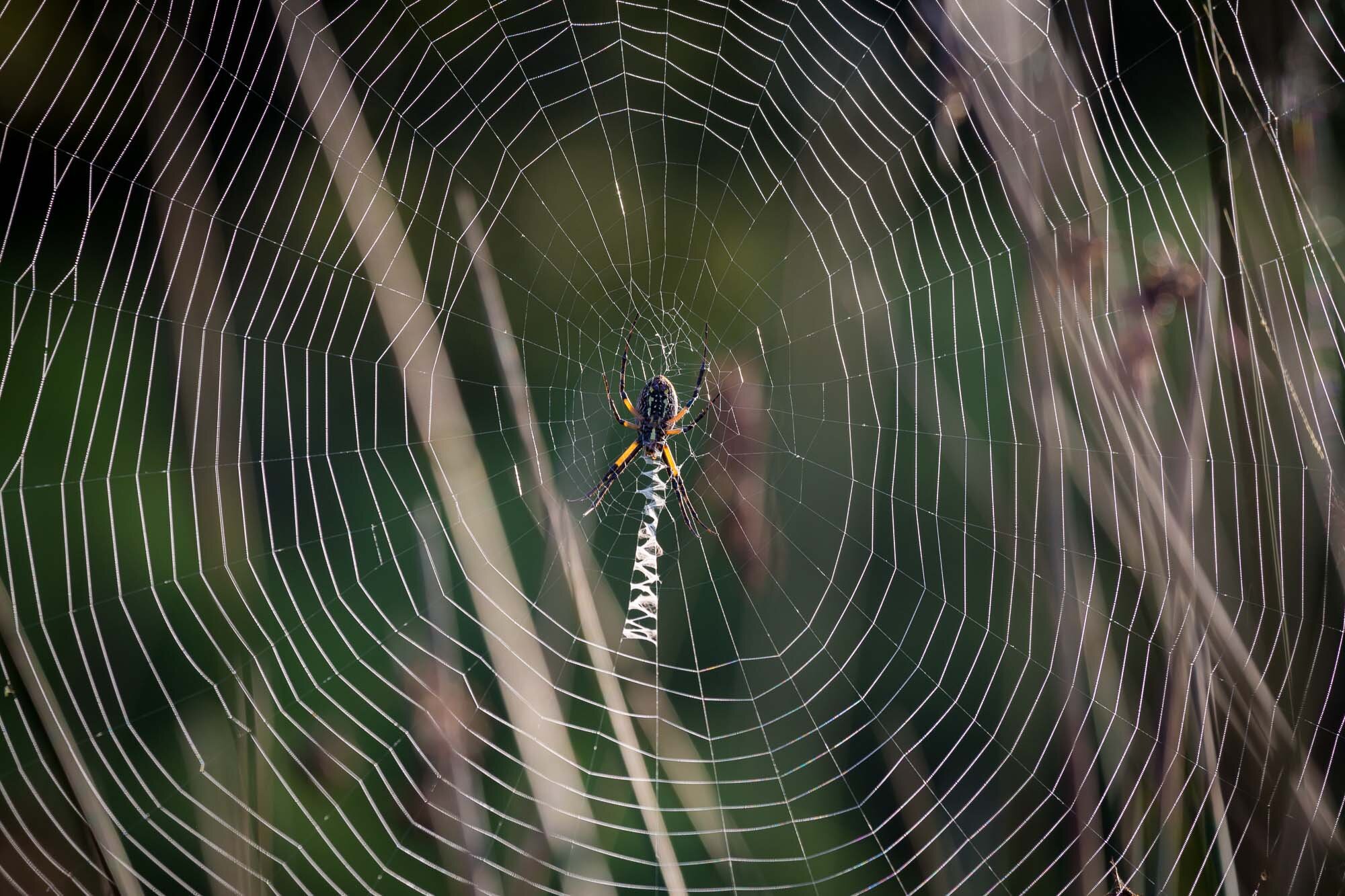The Spider Experience
~Written by Mark Kramer
Armand Bayou Nature Center maintains over five miles of the finest hiking trails in the Houston area. The trails route through one of the few historic forests left in Harris County and are fully shaded. This makes them an ideal escape for homebound Houstonians in the age of Covid-19.
If you walk the trails during the summer months, you are certain to see some arachnids, which may be surprising. I know that many of us have certain feelings about spiders. I hope that as you learn more about these beautiful coastal residents that your feelings may evolve. If you have never had the ABNC spider experience, now is the time. They are one of the most abundant and observable forms of wildlife on the refuge. You won’t travel far down any of the trails before you sight what is likely the biggest spider that you have ever seen perched on the biggest web that you have ever seen. But never fear, these massive beasts are generally harmless. The spider’s entire universe is the web. They depend on it for food and safety and never leave it (they won’t jump off on to you). More than once, I have inadvertently walked into a web during the work day and had one land on my face, but have never been bitten. In fact, in my forty years of hiking the trails, I’m yet to hear of one of these spiders biting a visitor- ever. All spiders can bite. However, these formidable predators reserve their bite for their prey.
All spiders which build their web in the shape of a wheel are included in the group of orb weavers | Photo by Gary Seloff
The two species of orb weaving spiders commonly seen from the hiking trails are the Golden Silk Spider (Trichonephila clavipes) and the Black and Yellow Argiope (Argiope aurantia). All spiders which build their nests in the shape of a wheel are included in the group of orb weavers. The Golden Silk Spider is the champion orb web builder and creates a web which may span over twenty feet! Their web has a beautiful property which reflects a vivid golden color when the sunlight is caught at just the right angle (hence the name - golden silk). Be sure to take a moment and position the web between you and the filtered sun through the trees. Move a few feet side to side or forward and back and when the angle is just right, you’ll have a memorable moment!
Spider silk is a miracle material which is the spider’s entire world for life | Photo by Mark Kramer
Spider webs are beyond beauty. They are essentially the spider’s whole world for the entirety of their life. The web hosts the spider and provides sensory communication of the surrounding environment or any prey that might have been trapped in the webbing. It’s a perception of the world entirely tactile, telegraphed through the line to the spider fingertips.
The web is designed to not only hold the spider, it is also an insect trap made of a sophisticated material. Imagine an insect in flight crashing into the web. First the material must be strong enough to endure the impact without breaking. No problem, the material is stronger than steel. Next the web must flex to bend with the impact absorbing the force as it hits. After flexing with the impact, the web must not trampoline the insect back into space. It accomplishes this, in part, with a sticky surface that holds the prey in place. These composite web properties that are described are produced from a special set of organs on the spider’s abdomen called spinnerets. Each spinneret contributing its own element to the composite masterpiece.
The silk and woven web it produces rivals man’s strong woven fiber, Kevlar. Kevlar is an industrial product used to make bullet proof vests. It’s made from petroleum products, which are then subjected to acid baths under high pressure and high temperature. Spider silk uses grasshoppers as raw material which are processed through the spider’s digestive system then extruded through spinnerets. Spiders may even eat their own web as raw material to make more web! Note to self- there’s a lesson here for humans too. Spider’s produce poop as a waste by-product, Kevlar produces industrial waste. Spider silk naturally decomposes, Kevlar does not.
This compared product analysis is increasingly being used by science to shape research. The field of biomimicry is an emerging science which looks to nature as inspiration for product design. It turns out that over millions of years, life has been perfecting her wares in a fashion that supports other life without destroying the environment which supports it. Spiders are just one of the species biomimicry is looking to for inspiration.
This year, for the first time in many years, I have hung hummingbird feeders around the house. Where typically I may find four or five silk spiders or argiopes, this year, there is only one. ABNC is an important hummingbird nesting habitat. A major material used in nest building is spider web. I suspect that the webs near my house were harvested by Ruby-Throated Hummingbirds for their nests. I enjoy the hummingbirds but have missed not having a friend outside my window.
Golden Silk Spider | Photo by Lyman Brown
The Golden Silk Spider is the species likely to be encountered on a woodland walk at ABNC. Also known as the Banana Spider, the species is present during the summer months. Females are large and are slightly smaller than an adult’s hand.
My friend and naturalist, George Regmund, relayed a remarkable Golden Silk Spider story. As he walked the forest trail, he saw a bird in the distance behaving very strangely. With his interest peaking, he approached the bird and found a tufted titmouse trapped and dangling in a web. The titmouse is a small bird, about the size of a sparrow. The bird had destroyed the web, but had managed to wrap a mass of spider silk around its feet. In spite of all its struggle and effort, it was not able to break free. Dangling upside down, the bird was doomed if not for our hero of the story! George carefully removed the bird and untangled the webbing from its feet. The bird was exhausted from the ordeal but managed to fly away. The moral of the story is of course that even nature’s strongest natural material is no match for the kind hands of a naturalist.
It is common among spiders for females to be noticeably larger than males | Photo by Lyman Brown
Males are about one quarter the size of females. In early September, females produce an egg case which resembles a ping pong ball in size and shape. Inside are hundreds of tiny spiders, which remain in the egg case until Spring. After egg laying, the adult spiders begin to decline. All adults die by late October. Essentially, the entire fate of the species lies with the young spiderlings which overwinter in the egg case and emerge in late Spring of the following year.
On September 13, 2008, Hurricane Ike made landfall on the Texas coast. The category two storm was broad in size. The eye of the storm passed directly over ABNC and delivered nine continuous hours of hurricane force winds.
Hurricane Ike brought significant impacts to forest dwelling species | Photo by Mark Kramer
The damaging winds brought extreme destruction to the forest which is critical habitat for the Golden Silk Spider. The hurricane couldn’t have come at a worse time. All of the spider’s egg cases had recently been deposited and were lying in the forest canopy. The fate of the next generation of spiderlings was at great risk. Ike lay waste to it all. Best estimates are that there was a fifty percent reduction in the forest canopy. Along with that downfall, came a near total destruction of the egg cases. The first year after Ike, the spiders were virtually absent from the woods. In fact, it has taken almost a decade for their numbers to recover to pre-Hurricane Ike levels.
Black & Yellow Argiope | Photo by Gary Seloff
Black and Yellow Argiopes, also known as the Yellow Garden Spider or ZigZag Spider, are grassland or forest edge species. I have never encountered one along a forest hiking trail.
Argiope’s weave a unique white silk pattern into the web | Photo by Gary Seloff
The name ZigZag Spider comes from the unique Z pattern of white silk woven into the web. Some research indicates that the reflective property of the white pattern reflects certain bands of UV light which resemble a similar UV frequency to flowers. The web’s UV reflection sends a pattern which may attract insects into the web. Other research has also suggested the pattern alerts birds in flight to avoid flying through the web.
Many native American cultures have great reverence for spiders. Some have a creation myth which includes the story of Spider Woman, who created the universe.
“There is a woman who weaves the night sky
See what she spins, how her fingers fly
She is within us, beginning and end
Our grandmother, our sister, our friend
She is the needle and we are the thread
She is the weaver and we are the web
She changes everything she touches
Everything she touches changes”
I had an Argiope make its web outside of my living room window last year. The web was inches from the glass, and I could admire her form, color and craftmanship regularly. At morning’s first light, she would consume the radial portion of the web and then re-weave new material. Some experts believe this behavior allows the spider to ingest moisture and trace minerals which adhere to the web. I never expected to develop a bond or friendship to a spider but every morning I would check to see if she was still there. I splashed water on her from my fingers during the dry months of summer and even caught several grasshoppers for her web. It was a sad day in the Fall when I woke one morning and she wasn’t there. Here is a beautiful video of this spider “re-writing” the zigzag pattern as she did early every morning as I watched in wonder.









